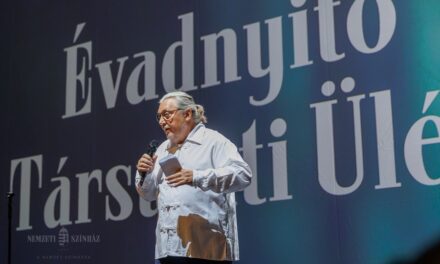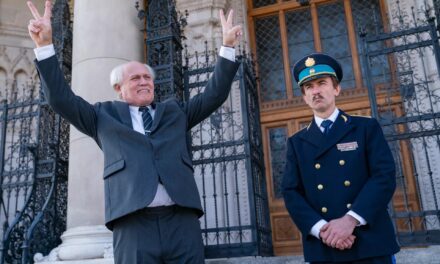About the invisibly strong spiritual fibers of the Carpathian homeland and Tibor Fábián's book
TIBOR FÁBIÁN (1974-) was born in Nagyvárad, Paris on the Pece side. He completed his university studies at the János Selye University of Révkomárom in the Uplands, at the Faculty of Reformed Theology. In 2008, he received a pastor's diploma. Before that, he obtained a journalism degree at the Ady Endre Press College in Várad (2004). Since 1993, he has been an editor-reporter of TVSZ cable television in Nagyvárad. Between 2002-2008, he was the deputy editor-in-chief of Agnus Rádió in Cluj. His writings appear in Transylvanian church newspapers, Magyar Nemzet, Tiszatáj, and the Erdély.ma portal. Congregation pastor. Most recently, three highly successful volumes were published: "Comrade Ceausescu, friend", "Monsters of Guyana" and "Ilyyen vulotm - Transylvanian stories". You can read an analysis of Guyana's monsters below, in a blog shared from the author's website, with a live illustration.
I myself have known the reverend writer for a long time. He was still the responsible editor of Harangszó in Varad, when I visited him in the editorial office as the responsible editor and pastor of Presbiter. Then in 2010, we organized the media conference of the Hungarian Reformed Presbyterian Association in Hidalmás, beyond Bánffyhunyad, near the place of service of the late László Ravasz, later Reformed bishop of the motherland. And when he was elected president of the former Literary Section of the College of Doctors of MRE, we also invited him to the presentation of church journalists working in the historical homeland. A lot of time is behind us, despite this, we follow each other's activities as church journalists and theologians with respectful respect and creative attention. We often exchange messages and our articles and writings form a living bridge. I have several spiritual ties to Felvidék, as does Tibor Fábián. As soon as the Theology in Révkomar started with the training of pastors, in the second half of the 90s, the Most Reverend Dr. Géza Erdélyi, the bishop at the time, invited him to teach as a teacher. I held my classes on Wednesday convocations. Then in the fall semester of 2001, I presented a history of Old Church dogma. In November 2016 and spring 2017, I was able to hold a Protestant social ethics series (on economic, cultural, eco-ethical topics, as well as on the sociology of world religions and the overwriting of the secularization thesis). The university also published the lectures in book format, which we gave together with Dr. Antal Birkás Ph.D. With Tibor Fábián, this is how Transylvania, the Highlands and the motherland connect us.
I am grateful to share the written fruits of this thought-provoking excellent book with our Dear Readers, accompanied by the letter that Tibor Fábián wrote in response to the following mini-essay.
TIBOR FÁBIÁN's letter from June 8, 2023:
Dear Lajos!
I read your excellent, insightful, analytical and explanatory work with a grateful heart. It clearly includes a thorough knowledge of the work. There are many reflections that have enriched me, as feedback and art analyzes are always of great importance to the author!
I also put it on my writer's page so that as many people as possible can see and read it (Currently, this writer's page has 805 followers and readers, and it is constantly growing).
With thanks and love:
Tibor
—
Tibor Fabián
pastor, journalist
https://www.facebook.com/profile.php?id=100063048679374
Question marks, exclamation marks from Transylvania - Pondering while reading Tibor Fábián's book
Tibor Fábián, Monsters of Guyana – Tortoma Könyvkiadó, Barót. 2021. 208 pages
Tibor Fábián , the pastor-author of several volumes, gives a special extra to the dozens of question marks and exclamation marks posed in the exciting stories of the primeval forest in this masterpiece. In fact, even the end of the novel dot, dot, dot is a punctuation mark indicating a continuation. These punctuation marks go far beyond themselves. Beyond the specific situation. Where one of the characters utters these words, either in the Catholic retirement home in Georgetown, or in the green Guyana forest, which is beautiful in itself, when, for example, one of the protagonists, the confessing Father Luis, is about to be tied to a torture stake and beheaded. Or when the helicopter with the staff of the American TV company NBC and Father Roger crashes after the arrow shot with deadly accuracy by the Indian chief Quaria. In a varied series of life-death situations and in the silence of remembrance and the final reckoning, even though the sentences with question marks and the exclamation marks of woe are formulated, the punctuation marks always point beyond themselves. Completing and delivering their transcendent and even transparent messages to the readers. Because the punctuation marks do not lie: they are signs of existence, even visions of the person in whose mind and mouth they are formed. In the unimaginable primeval forest events, in the breath-taking hustle and bustle of unexpected turns. Not only as individual signs of fate , but as the way of life . And about the not infrequently cruel conflict in which the native Indian culture defends itself, its belief system, superstitions, wizard-tribal chief internal power structure and practices against the invaders, against the cruel civilization of the forest-destroying, fortune-hunting whites. In the primeval forests, the large river Essequibo, and their sacred mountain, these writings are signs of existence sent by the various tribes living in the Baruma region. They are not mystical, but realistic signs with a message , extracted from the reality of what is happening with the logic of generalizability , and dripped into the social fabric of fear, uncertainty, terror, already universalized into a symbolic horror carrier . These visual punctuation marks are the message bearers of reality in the whirling flow of events, whether it is about the more peaceful mandukas, pigs, or white Indians. Or about the bloodthirsty Carabias, the cursed Dramuras, turn into killing machines under the influence of their berry concoction, navarcon, even a machete or Turning the beautiful green primeval forest into a land of monsters, which the Almighty created in his good humor.
The reader can perceive well that in many moments of this great visual novel, it can be transferred to other contexts, be it European, Central European, or even African. After all, just as in the primeval forest, in Europe of decaying forests, and in the terror of destructive paramilitary African organizations, deep-rooted cultural and ethnic, religious traditions can be found, as well as the ferocious struggles of modernity, galloping technical civilization, a different way of life driven by group interests and hunger for profit. Very brutal manifestations of the untamed struggle for life And in all of this, the life-giving presence of the Christian values and value system is pure water, still flowing between us and in us in the capillary system, but the tension that threatens to dry up in many parts, sometimes with conflicts that can hardly be reconciled. The author has succeeded in creating a system of real-symbolic questions and exclamation marks that prompts and even forces the reader to confront his own inner worldview, the hedgehog-like set of opinions and distorted judgments of his environment, in Transylvania and in Hungary, and wherever he takes it in hand and interprets it, the multi-story book messages. The transparency and transparency of the punctuation marks, and the content of meaning that always goes beyond itself, with the twists and turns and excitement of the plot weave, constantly exercise the mind of the person turning the pages of the book, namely with its movement from specific cases to universal and general validity. To the extent that it certainly raises thought-provoking negative trends and world phenomena that operate regardless of skin color, tribal or national or international affiliation. The author uses the "Rutacca" to introduce them into the story. The Rutacca way of being is a terrible and real, personal display of evil, with the design of the primordial snake on its forehead, almost indestructible even in its individual existence. Cynically and bloodcurdlingly laughing at everyone, depicted in the novel as a sick woman who is evil personified. The evil one. The man-monster, undead Rutacca is not actually human, not Indian. But it is the negativity that accompanies and tempts humanity, the primordial principle of darkness. This is what he says to Father Roger, who is fighting him, in the death throes of the showdown: " Just kill me! You can't run away from human monsters anyway. You take death with you wherever you go! ” (207). He is the super-personal, sub-personal, and terrible dregs and burden of human existence that penetrates the personality of people of all times, since the case of the first human couple. The individual and the community have to constantly fight with it, whether they live in Guyana's lyrically thousand-melodic, bird-song primeval forests, in the fantastic play of green and blue, and in the hidden cursed land, in hell on earth or anywhere in the world. That is why Father Roger, an American priest in jeans who connects the two parts of the novel, the the Confession and the 14 chapters of the New Mission , says on the concrete of the military airport in Kumak: " This is not the end of the war, because it will continue with further battles against evil ” (208).
In the real-symbolic horror novel, in the whirlwind of action, which absorbs the horror like a swirling force and keeps the reader's attention awake, we meet strange characters and ethnic groups . With good and bad, positive and negative. Among them is a benevolent Indian or missionary father. Especially in the Confession section, the presence of the author's priestly habitus can be felt, Luis Ferguson determined to go to confession, and in Roger, the young American missionary's search for a place of service and interpretation of his mission. Father Luis has been carrying a sin (26) for 50 years, which he cannot die without confessing. It is long and the story told in his last days on earth is very colorful and complicated. On page 113, we learn that by killing one of the Caribbean Indians who wanted to execute him in a life-or-death situation, Rucanda , defending his young Dramura Indian brother, goes as far as to commit the crime: " My God! I killed a man! Where have I sunk! ". He protected Rucanda, who through his father became acquainted with Father Vito , who went to the primeval forest decades before Luis to convert the Indian tribes retreating from the white man to Christianity. His father left the honor of the missionary to his son , and he found the cross painted with blood during Father Vito's execution, which he had impaled under his head, in the mud. Following the example of his father, Rucanda proved: "There could be a true, sincere friendship between a Dramura warrior and a white man" (70). Lo and behold, Father Vito's missionary sowing still bore fruit decades later, even in his descendants (71). His mission goal , which was equally present in the multi-generational risk-taking determination of the three priests - Vito, Luis and Roger, was simply this: " I tried with all my might to sow the seeds of faith in their hearts, to make them know the love of the Saviour " (28). At the end of the Confession, we learn that Father Luis buried Rucanda next to the river bank with his remaining strength in the soul-shattering and physically exhausting moments of life-saving running and escape. " I fabricated a cross from some branches. To the dramura who loved the Christian God " (117). We also find a sympathetic native, Masiru, in the New Mission section . He protected him on Kígyó island and then as a messenger in the city, leading the film crew to get home alive. He directed the helicopter ambulances in pursuit of the fugitives - Liz, Roger - who were fleeing the rapidly mutating world-destroying virus (Covid, and the "evil lurking in the dark"). He was in the plane that exploded over the primeval crowd. He was also the one who interpreted the " Lukumba Testament " for the American film crew, which was still full at the time, on Snake Island of their more peaceful tribe, the Lukumbas. This was left to them by an old Indian woman with a wrinkled face: " Men! Don't make the mistake we made of waiting 4 days and 4 nights in the belief that the evil will leave. It won't go away. And in the end we will leave. Men! Hear my voice! Get out of this place, for wherever the human monsters set foot, that place will be cursed, and they will not return underground. Look for a new country if you want to live. If you want your children to grow up! ” (171).
Would this really be the solution? The escape from evil? But where? Where is he not present, even ahead of Indian and white man? In Guyana or Europe or anywhere in the world?! So what is the solution? In the midst of uncertainty, earthly fates teetering on the edge of existence and non-existence, deep forest culture and the white man's technical civilizational pressure and counter-pressure? When Father Roger flees from the rutacca (attack) in his military jeep at the closed and destroyed Kumak airport, the author comments this way: The lights of hope, survival and a new beginning appeared in the contours of the not-so-distant city. But even in this looming light, the fear-inducing, uncertainty-producing horror power wrote its sign of majesty, in the last sentence of the novel: "It's like a long, illuminated creeper silently, quietly heading towards its destination ..." (208) After question marks and exclamation marks, what happened (?) keeping the unfinished history open with three points indicating its continuation...
I tried to put my analytical notes into a transparent framework on nine pages, following the lines of Tibor Fábián (1974- Nagyvárad). The primeval world of his Transylvanian pastoral and literary memories, contemporary and contemporary memory and memory imprints, which emerges in every sentence of The Monsters of Guyana . The book's multi-layered flow of messages would be narrowed by sorting, naming, and localizing it, what could be the thing that connects this with the other two volumes. Ceauşescu Comrade, Paitás (2021) and Ilyenek vyltom - Transylvanian Stories (2022) often surpasses fantasy. Sometimes even common sense. Substitution would only mutilate the creative spaciousness, the universal messages that prevail in the remote forests and beyond the Transylvanian Carpathians. Everyone should do this through the prism of their own temperament and experience. In my notes, I filled several columns with quotations. With the multitude of question marks, exclamation marks, listing and characterizing Indian tribes, geographical locations. By analyzing the characters, interpreting specific Indian concepts and words. With special formulations, sociological readings of experiences between generations. With strange, original twists and theological sentences. the Guyana syndrome (fear, insecurity, destruction of forests and people, ancient culture, fighting everyone against everyone, plasticity, living in a mouse hole, uprooting, with the story cores of forced resettlement in the city). The prose description of the author's eco-lyric about the green wonderland is also included. About the role of dreams. And the prayers! I will also use the written content in a larger book presentation. I am convinced that many of us can get rich in many ways from the contemporary and humanistic environmental horror novel that presents the monsters of the recent past and today.
Finally, some personal words. The author dedicated the volume sent to me as follows: " Theology is in everything. Also in this doomsday story ”. You're right. In everything there is theology, the heavenly science of goodness-beauty-truth, the coordinate system of the Bible. Father Roger took a pocket copy of this with him in his waistcoat pocket to the winding river and among the happy and singing little Indians of Snake Island. Because the Bible is also a handbook of knowledge of evil-ruth-lies, (sa rutacs) self and history. And much more, the gospel of joy and salvation, happiness. Indeed, there is theology in everything - but not everything is theology! Everything includes the vox humana included in vox divina (divine voice, human voice conceived in speech, humane word, healing speech rooted in the Bible). Tibor Fábián gives readers both. Thank you very much! Because as Father Luis put it sixty or seventy years ago: " The only property I can leave to this world is my story "...
Dr. Lajos Békefy Ph.D.
pastor-publicist, he was the president of the Literature Section of the MRE College of Doctors












